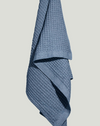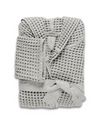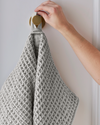Education
When Were Towels Invented: The History of Towels
Published
April 23, 2024
Reviewed by
Suze Dowling

Towels, seemingly mundane yet essential, play a role in all of our daily lives. From drying off after a refreshing shower to enhancing the aesthetics of a well-appointed bathroom, towels have woven themselves into human existence.
We’ll get into the fascinating journey of how these ubiquitous household items came to be, tracing their origins through the annals of time. Exploring the history of towels offers a glimpse into the evolution of fabric, function, and cultural practices that have shaped these seemingly simple yet significant linens.
What Are the Ancient Origins of Towels?
In the depths of ancient civilizations lay the humble beginnings of what we now call towels. From rudimentary pieces of cloth to absorb moisture to more refined textiles, the concept of the towel evolved as human civilizations progressed.
While precise records are scarce, ancient texts and artifacts provide clues to early towel usage. Some speculate that towels appeared in ancient times as early as Mesopotamia and Egypt, where woven fabric served functional and ceremonial purposes.
As societies advanced, so did the towels. What began as basic linen strips grew in size and utility, with evidence suggesting the Greeks and Romans used towels for bathing and sports activities. These early versions were likely far removed from the plush bath towels we know today but laid the groundwork for the essential role towels would come to play in personal hygiene and comfort.
Medieval and Renaissance Era Towels
Transitioning through time, towels continued to hold significance in the medieval and Renaissance periods, albeit with varying practices and materials. During medieval times, towels served practical functions beyond drying, often doubling as napkins or even strung as decorative banners during feasts and ceremonies. The materials used were typically coarser compared to modern standards, reflecting the available resources of the era.
As the Renaissance dawned, towel-making underwent a renaissance of its own, witnessing advancements in weaving techniques and luxury materials. Elaborate embroideries and intricate designs adorned towels used by nobility, reflecting the refined tastes and social status of the elite. Towels became symbols of opulence and sophistication, showcasing intricate craftsmanship and attention to detail.
Towels In the Age of Exploration and Colonialism
The age of exploration and colonialism heralded a new chapter in the history of towels as trade routes expanded, bringing exotic textiles and weaving techniques to distant lands. Towel production diversified with the introduction of novel fabrics like silk and regional specialties such as Turkish towels, renowned for their softness and absorbency.
Colonial encounters intertwined various towel traditions, resulting in a fusion of styles and patterns. The global exchange of goods and ideas facilitated the cross-pollination of towel-making techniques, giving rise to a rich tapestry of cultural influences reflected in the towels of the era. Towels became functional items and artifacts of cross-cultural exchange and historical significance.
As we journey through the annals of time, the evolution of towels mirrors the changing tides of human history, shaped by cultural, economic, and technological shifts that have left an indelible mark on these seemingly ordinary yet indispensable linens. Join us as we explore further into the Industrial Revolution and modern innovations that have sculpted the towels we know today.
The Industrial Revolution and Modern Towels
The Industrial Revolution brought about a dramatic transformation in the towel industry, revolutionizing the way towels were manufactured and distributed. The advent of mechanized looms and mass-production techniques enabled towels to be produced more efficiently, making them more accessible to a broader segment of society. This shift marked a pivotal moment when towels transitioned from luxury items to everyday essentials in households worldwide.
With the rise of industrialization came innovations in textile manufacturing, which introduced new fibers and weaving methods that enhanced the quality and durability of towels. The emphasis on functionality and practicality grew, prompting the development of softer, more absorbent towels tailored to meet the evolving needs of consumers.
Towels became not just utilitarian items but also a reflection of changing lifestyles and domestic comforts.
Technology and Innovation in Towels
In the contemporary era, technology and innovation have continued to shape the evolution of towels, pushing boundaries in design, performance, and sustainability. Modern materials like Supima cotton have emerged as premium choices for towels, offering superior strength and softness compared to traditional fabrics. Waffle-knit patterns have gained popularity for their quick-drying properties and enhanced breathability, catering to the demand for towels that are both functional and luxurious.
Advancements in towel design have prioritized efficiency and convenience, with features like antimicrobial treatments and accelerated drying capabilities becoming standard in the industry. The marriage of technology and textile craftsmanship has led to the creation of towels that not only meet but exceed the expectations of consumers, offering a blend of comfort, durability, and aesthetic appeal.
As we look a bit deeper into towels, we uncover a household item defined by innovation, sustainability, and a commitment to quality that embodies the spirit of progress and excellence in the world of towel design and production. Let’s explore towels' cultural significance and global impact in the modern era.
What Is the Evolution of Towel Culture Globally?
Diving into towel culture globally reveals a rich mosaic of traditions, customs, and uses that span continents and centuries.
From the hammams of Turkey to the onsens of Japan, towels have played integral roles in rituals of relaxation, cleansing, and rejuvenation across cultures. Each region has its unique approach to towel usage, from the elaborate towel dances of Middle Eastern celebrations to the intricate towel origami of luxury hotels.
As towels migrated through trade routes and colonial expeditions, they became ambassadors of cultural exchange, carrying with them the stories and symbols of their place of origin. The adoption of diverse weaving techniques, patterns, and motifs infused towels with a sense of heritage and identity, transforming them into more than mere functional items but embodiments of tradition and artistry.
How Does Sustainability Come Into Play?
In an era increasingly defined by environmental awareness and eco-conscious practices, the towel industry has embraced the principles of sustainability and ethical production.
Brands are turning toward eco-friendly materials, organic fibers, and responsible manufacturing processes to reduce their carbon footprint and minimize waste. Recycled textiles and water-saving techniques have become standard practices, reflecting a shift toward a more environmentally friendly approach to towel production.
The concept of sustainable design extends beyond materials to encompass the entire lifecycle of a towel, from sourcing raw materials to end-of-life disposal. Consumers are increasingly drawn to towels that meet their functional requirements and align with their values of environmental stewardship and social responsibility.
The movement toward sustainable towels mirrors a broader shift in consumer behavior toward conscientious consumption and a desire for products that enrich their lives and contribute positively to the planet.
As the towel industry continues to evolve in response to changing consumer preferences and global challenges, brands like Onsen stand at the forefront of innovation, championing sustainability, quality, and conscious design.
The Takeaway
In an age where sustainability and eco-conscious practices are at the forefront of consumer consciousness, the towel industry has responded with a resounding commitment to ethical sourcing, responsible production, and mindful consumption.
As brands like Onsen lead the charge toward a more sustainable future, balancing quality, functionality, and environmental stewardship, we recognize towels' pivotal role in shaping our everyday lives and our collective journey toward a more sustainable world.
Check out our towel collection today to enjoy luxury in your own home.
Sources:
A Timeless Fabric: The Historical Evolution of Linen | Earthy Textiles
How Are Soft and Fluffy Towels Made? | Britannica
A Brief History of Turkish Towels | Handwoven Magazine
When Were Towels Invented? A Look at the History and Evolution of Towels | TFFN













